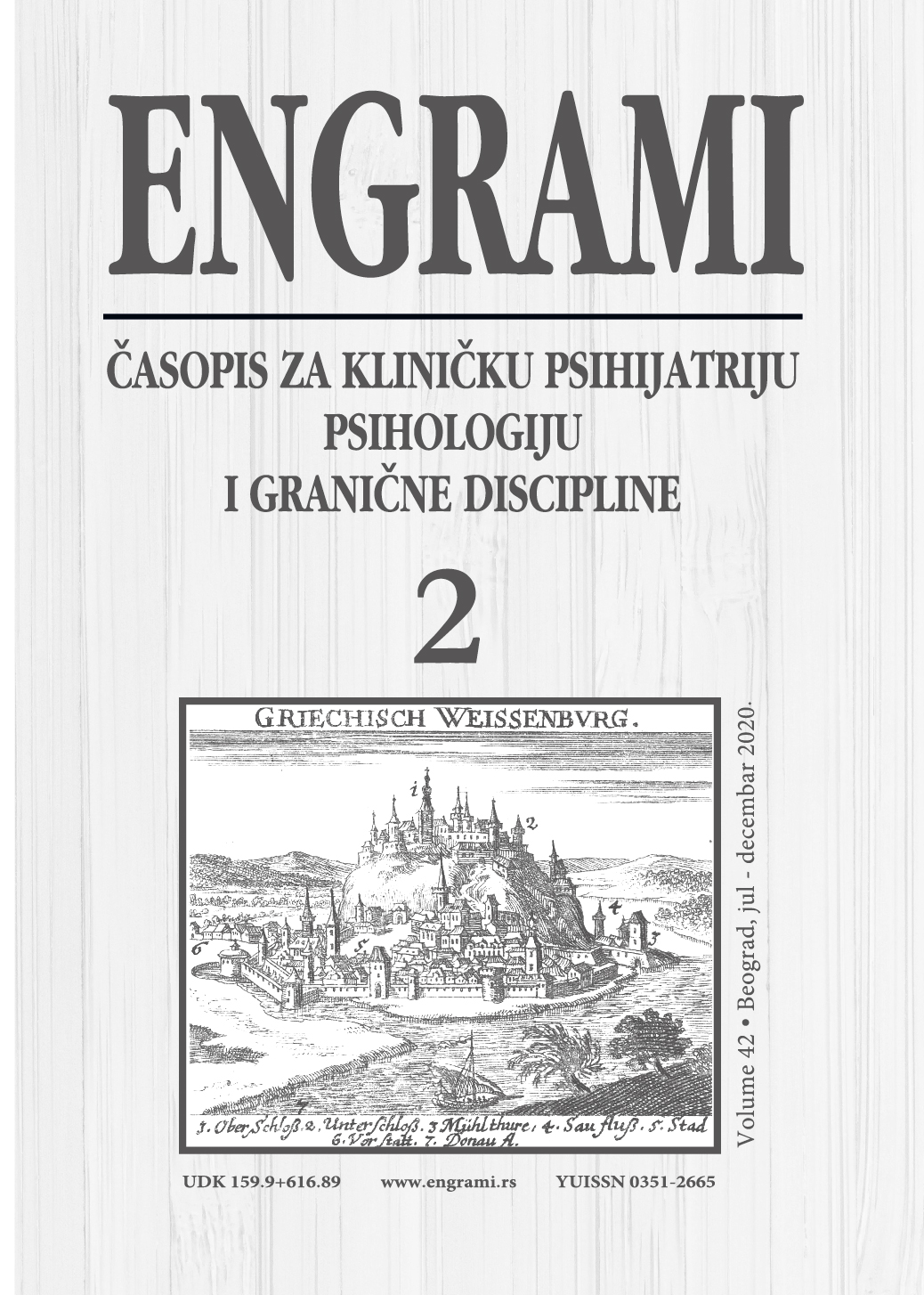Prevod na srpsi jezik i validacija Revidirane skale osetljivosti na gađenje
Sažetak
Gađenje bismo mogli definisati kao osećaj odbojnosti koji nastaje kao odgovor na averzivni stimulus, koji indukuje motivaciju za povlačenje iz tog stimulusa. Postoji nekoliko instrumenata za merenje osetljivosti odvratnosti, a najkorišćeniji je inventar izazivača gnušanja, Skala osetljivosti na gađenje (eng. Disgust Sensitivity Scale). Cilj ove studije bio je da potvrdi prevod pomenute skale na srpski jezik.
Uzorak korišćen za ovu studiju brojao je 724 učesnika, od kojih se 513 (70,9%) izjasnilo kao žensko, a prosečna starost učesnika bila je 28,3 (SD = 6,9) u rasponu od 18 do 66 godina. Uzorak je prikupljen putem internet ankete. Test baterija se takođe sastojo od skale za depresiju, anksioznost i stres (DASS21) i upitnika za zdravlje pacijenta 15 (PHK15).
Testirali smo nekoliko modela strukturnih skala, uključujući jedan, tri, pet i šest faktorskih modela predloženih u različitim prevodima i iteracijama skale. Nijedan od njih nije pokazao da je postigao adekvatne kriterijume prilagođavanja modelu u potvrdnoj faktorskoj analizi, ali model sa 6 faktora ima najbolje metrike. Međutim, subskale u ovom modelu imaju nisku unutrašnju konzistentnost. Otkrili smo očekivanu polnu razliku u zbirnim rezultatima. Gotovo da nema značajnih korelacija sa bilo kojim drugim izmerenim konstrukcijama, što dovodi do dalje sumnje na skali. Vaga ima dobru vremensku stabilnost.
Preporučujemo upotrebu ove skale sa oprezom i korišćenje samo sumativne ocene, naše istraživanje potvrđuje da sve veći deo rada pokazuje da su skale osetljivosti na gnušanje zasnovane na elicitorima pod velikim uticajem sociokulturnog okruženja i da ih je teško preslikati u različitim kulturama. Stvaranje skale osetljivosti na gađenje zasnovano na kulturi zasnovanoj na elicitoru verovatno je najbolje rešenje za merenje ovog konstrukta.
Reference
Rozin P, Haidt J, & McCauley CR. Disgust. In: M. Lewis, & J. M. Haviland-Jones, Handbook of emotions, 2nd Edition. New York: Guilford Press; 2000. p.637-53.
Olatunji BO, Cisler JM, Deacon BJ, Connoly K, & Lorh JM. The Disgust Propensity and Sensitivity Scale-Revised: Psychometric properties and specificity in relation to anxiety disorder symptoms. J Anxiety Disord 2007; 21(7): 918-30.
Giampietro M, Ruggi S, Caravita SC, Gatti M, Colombo L, Gilli GM. A Measure to Assess Individual Differences for Disgust Sensitivity: An Italian Version of the Disgust Scale - Revised. Curr Psychol, 2017.
Woody SR, Tolin DF. The relationship between disgust sensitivity and avoidant behavior: Studies of clinical and nonclinical samples. J Anxiety Disord 2002; 16(5): 543-59.
Druschel BA, Sherman, MF. Disgust sensitivity as a function of the Big Five and gender. Pers Individ Dif 1999; 26(4): 739-48.
Olatunji BO, Haidt, J, McKay D, David B. Core, animal reminder, and contamination disgust: Three kinds of disgust with
distinct personality, behavioral, physiological and clinical correlates. J Res Pers 2008; 42(5): 1243-59.
Haidt J, McCauley C, Rozin P. Individual Differences in Sensitivity to Disgust: A scale sampling seven domains of disgust elicitors. Pers Individ Dif 1994; 16(5): 701-13.
Olatunji BO, Sawchuk CN, Arrindell WA, Lohr JM. Disgust sensitivity as a mediator of the sex differences in contamination fears. Pers Individ Dif 2005; 38(3); 713-22.
Ille R, Schoggel H, Kapfhammer H.-P, Arendsay M, Sommer M, Schienle A. Self-disgust in mental disorders -symptom related or disorder-specific? Compr Psychiatry 2014; 55(4): 938-43.
Mancini F, Gragnani A, D'Olimpio F. The connection between disgust and obsession and compulsions in a nonclinical
sample. Pers Individ Dif 2001;31(7): 1173-80.
Moretz MW, McKay D. Disgust sensitivity as a predictor of obsessive-compulsive contamination symptoms and associated conditions. J Anxiety Disord 2008, 22(4), 707-15.
Tolin, D. T., Woods, C. M., & Abramowitz, J. S. (2006). Disgust sensitivity and obsessive-compulsive symptoms in
a non-clinical sample. J Behav Ther Exp Psychiatry 2006; 37(1): 30-40.
van Overveld M, de Jong PJ, Peters ML The Disgust Propensity and Sensitivity Scale-Revised: Its predictive value for
avoidance behavior. Pers Individ Dif 2010; 49(7): 706-11
Ahroni R, Hertz MM. Disgust Sensitivity and Anorexia Nervosa. Eur Eat Disorders Rev 2011; 20(2): 106-10.
Inbar Y, Pizarro DA, Knobe J, Bloom P. Disgust Sensitivity Predicts Intuitive Disapproval of Gays. Emotion 2009; 9(3):
-9.
Inbar Y, Pizzaro D, Iyer R, Haidt J. Disgust Sensitivity, Political Conservativism and Voting. Soc Psychol Personal Sci 2012; 3(5): 537-44.
Wagemans FM, Brandt MJ, Zeelenberg M. Disgust Sensitivity is Primarily Associated with Purity-Based Moral Judgements. Emotion 2018: 227-89.
Rozin P, Fallon A, Mandell R. Family resemblance in attitudes on food. Dev Psychol 1984; 20(2): 309-14.
Olatunji BO, Williams NL, Tolin DF, Abramowitz JS, Sawchuk CN, Lohr JM, Elwood LS. The Disgust Scale: Item Analysis, Factor Structure, and Suggestions for Refinement. Psychol Assess 2007; 19(3): 281-97.
van Overveld M, de Jong PJ, Peters ML, Schouten E.The Disgust Scale-R: A valid and reliable index to investigate separate disgust domains? Pers Individ Dif 2011; 51(3): 325-30.
Olatunji BO, Unoka ZS, Beran E, David B, Armstrong T. Disgust Sensitivity and Psychopathological Symptoms: Distinction from Harm Avoidance. J Psychopathol Behav Assess 2009; 31: 137-42.
Kang J, Kim S, Cho H, Jhung K, Lee S, Lee E, An S. Psychometric analysis of the Korean version of the Disgust ScaleRevised. Compr Psychiatry 2012; 53(5): 648-55.
Jovanović V. Gavrilov-Jerković V. Žuljević D. Brdarić D. Psihometrijska evaluacija Skale depresivnosti, anksioznosti i stresa21 (DASS-21) na uzorku studenata u Srbiji. Psihologija 2014; 47(1): 93-112.
Rokvic N. Initial Investigation of Somatization in the General Population of Serbia: Prevalence, Manifestations and
Predictors. Med Pregl 2018; 71(11-12): 360-67.
Browne MW, Cudeck R. Alternative ways of assessing model fit. In K. S. Bollen, Testing structural equation models 1993. Beverly Hills, CA: Sage.
Bentler PM. Comparative fit indexes in structural models. Psychol Bull 1990; 107(2): 238-46.
Akaike H. Factor analysis and AIC. Psychometrika 1987, 52(3), 317-32.
Schwatz GE. Estimating the dimension of a model. Annals of Statistics 1978; 6(2): 461-64.
Olatunji BO, Moretz MW, McKay D, Bjorklund F, de Jong PJ, Haidt J, . . . Schienle A. Confirming the Three-Factor
Structure of the Disgust Scale Revised in Eight Countries. J Cross Cult Psychol 2009; 40(2): 234-55.
Bjorklund F, Hursti T. A Swedish translation and validation of the Disgust Scale: A measure of disgust sensitivity.
Scand J Psychol 2004; 45: 279-84

